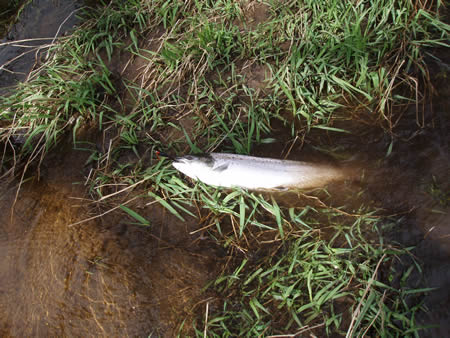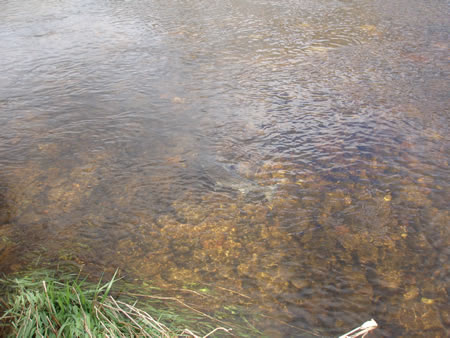These bulletin blogs represent news about Finavon and the South Esk, and my views as a riparian owner. They are not the views of any other organisation, nor are they designed to promote the interests of any individual or organisation other than Finavon Castle Water and factors affecting the fishery. Tony Andrews
The last full week of April was very wet with a high and coloured river, and some salmon showing in the pools as they swam through the 4 beats of Finavon. I saw what I think may have been the first sea trout sighting of 2012 in the shape of a fresh fish of about 3lbs jump about 2′ clear of the water in the Willows. Two salmon were hooked and lost, and four caught and returned, of which the biggest was 15lbs. The picture below is of a 7lbs fish caught in Upper Boat Pool in a falling (but still high) river, tinged with peat and very cold.
7lbs salmon caught in Upper Boat Pool on 28 April 2012 in high water
I have said before in these blogs that, unlike the North Esk where there is a counter, no-one really knows how many spring salmon run the South Esk every year. People say that spring salmon stocks in the river are fragile, but the only evidence produced, when you ask them to substantiate their claim, is rod catches. Therefore estimates of abundance of spring salmon are largely speculation, and mostly unfounded at that!
The most experienced scientists and more enlightened managers recognise that rod catches can play a useful part in stock assessment, mainly to corroborate data from more reliable sources. I am told that, because there is no other way of assessing salmon and sea trout catches on the South Esk, rod catches will have to do. Now, I am not saying that the river’s spring salmon run is entirely healthy because, as everyone else should be admitting, I honestly don’t know whether it is or not, except on the basis of my own observations and those of my upstream neighbour at Inshewan.
With 10 spring salmon recorded at Finavon to date (28/4) and reasonable numbers of fresh fish showing in the river I can say that our catches are normal, but that doesn’t tell me much about the bigger picture. If we are dealing with fact, as opposed to speculation, we know that improvements to the Kinnaird dyke allow fish to access the upper river in nearly all temperatures and conditions. We may therefore assume that spring salmon will be able to disperse throughout the South Esk catchment much earlier in the season than in the past.
The result of this dispersal is that salmon are liable to be spread thinly thoughout the catchment, and many of these fish will be unavailable to anglers, whereas when they were trapped below the Kinnaird dyke obstruction in the low water temperatures of late winter and early spring, they were available in an unnaturally high density to the then heavy angling pressure on the Upper Kinnaird beat. Spring catch figures over the last 50 years (See bulletin blogs for details in December 2011, January and February 2012) for the South Esk show that all the dykes, but especially Kinnaird, had a profound effect on the movement of spring salmon. Many of us have noted in recent years that angling pressure has eased in the spring months, to the extent that, for example at Finavon, there are many days without rods and others with only one or two rods on an eight-rod stretch of the river.
If we deal in facts, which I prefer to do, we have noted that in 2012 the spring salmon caught and returned have all been in excellent condition. These fish have clearly had access to good feeding at sea and are entering the river with stores of fat to see them through the eight months or so until they spawn. The females are clearly in a condition to be carrying large, high quality ova, and on that depends the strength of the next generation of spring fish. It is also the reason why the current Marine Scotland radio-tagging project is so useful. When we know where these spring fish spawn, and where their progeny grow up as juveniles, we can target those areas to make sure that their specific habitats are optimal for young salmon. Then we must start measuring their abundance – counting them – which will open up a whole new debate in the district!

